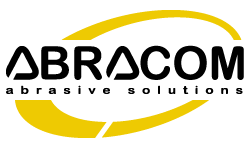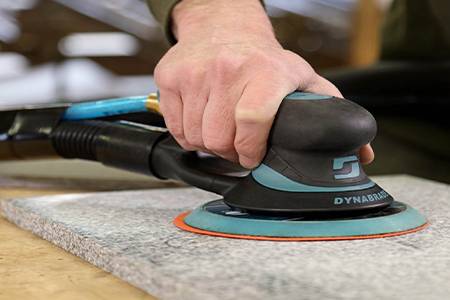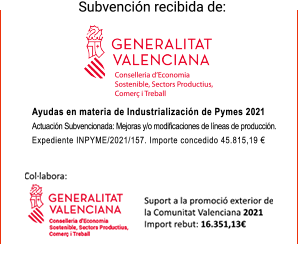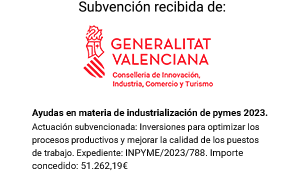¿Necesitas un lijado de precisión sin dañar superficies delicadas? Descubre las ventajas del disco de espuma estándar...
}What grinding wheels are
Mechanical wheels are abrasive tools that adapt to different shapes, providing an ideal damping action for both irregular and flat surfaces.
They adapt to complex contours and shapes. They are designed to offer a uniform finish with a constant cutting ratio. They wear down evenly without leaving any residue, continuously exposing the new abrasives.
Composition of grinding wheels and/or brushes
Both compact abrasive wheels (convolute) and non-compact sandpaper brushes (flap) are made up of three basic elements: the support material or fiber, the binding agent or resin and the mineral of the abrasive itself.
The hardness, structure and type of mineral will be the determining factors when choosing which wheels to choose, also taking into account the degree of finish that is sought, what are the properties of the material to be treated and which is the shape or profile of the piece.
Support material
The support material is a synthetic nylon fiber. This non-woven fiber, as a skein, can have a greater or lesser density, thus determining the degree of hardness. In the case of flap brushes, the support material consists of sheets of non-woven fiber. The higher the number of sheets, the greater the density of the brush. Density scaling usually ranges from a scale of 5 to 10, 5 being the softest density 5 and 10 the hardest density.
The open structure of the support and its density provide versatility in the work. We can find from fibers or damping sheets to compact agglomerates, hard cleaning and finishing.
Binders
The abrasive minerals are fixed to the fibers of the non-woven material thanks to the resins or binders that impregnate them. They are usually uric or phenolic resins that do not stain or discolor surfaces, avoiding leaving any trace or contaminant. They are resins resistant to temperature changes and can be used for wet or dry work.
Minerals
Basically there are two minerals used. Aluminum oxide ore designed for jobs with a higher cutting ratio: thick, medium and fine finishes; and silicon carbide ore for very fine, ultrafine and microfine finishes.
Types of grinding wheels
We have wheels in different diameters, grades and densities for the removal of rust, glare and burrs, reduction of surface roughness, smoothing of weld seams and surface stripes in stainless steel, polishing of weld seams and execution of decorative finishes.
They are available both in the flanged version with a central core for mounting on the different bench machines, and with a 3 or 6 mm steel shaft for the different portable machines.
We can distinguish between three main types of abrasive wheels.
Compact abrasive wheels:
Compact or also called "convolute" abrasive wheels are formed by wrapping non-woven fiber material, better known as "non-woven" abrasive around a central core and adhering the layers together to create an abrasive wheel.
Abrasive flap brushes:
Similarly, non-compact grinding wheels or, also called "abrasive flap" brushes, are formed of sheets of non-woven abrasive fiber mounted side by side around a central core. This construction makes these brushes or grinding wheels in one of the best solutions when adapting to different shapes.
The main application of these brushes or wheels are surface finishing.
Mixed flap abrasive brushes:
There are brushes that interpose sheets of abrasive fiber with sheets of cloth or abrasive paper. These flap brushes are more aggressive than those with only fiber. They offer a higher cutting ratio. The proportion between sandpaper and fiber sheets can be modified to suit different applications. They are less conformable, and therefore more rigid and serve to quickly remove more material. They should always be used in the direction indicated by the arrow on the product label.
What are they used for
Grinding wheels and flap brushes have countless uses.
Compact wheels or convolute wheels can perform multiple functions:
For deburring in general, smoothing and finishing in metals, wood and glass
Material removal, fast and aggressive cutting with excellent shape preservation
Deburring, smoothing and finishing of automobile gears and turbine engine components.
Decorative finish in plumbing installations.
Metal finish and smoothing of weld seams during manufacturing.
Flap sanding brushes are generally used for polishing and finishing operations:
Constant removal of material and corrosion..
Plywood smoothing.
Scraping of paints and varnishes. Sanding primer.
Preparation of aluminum surfaces before anodizing.
Preparation of welded surfaces in general.
Make matte, satin and gloss finishes..
Light metal cleaning..
Superfinishing
Mixed flap sanding brushes are used for coarse sanding and grinding operations:
Deburring and reviving in stainless steel.
Preparation of metal to paint.
Slight finishing marks.
Smoothing of metal surfaces.
Application of light surface stripes.
Cleaning and fine smoothing
You may be interested: Abrasives and industrial machinery: products for a perfect finish
How to choose the wheels that best suit what we need?
To succeed in choosing the most suitable wheels or brushes we must assess the following aspects:
Shape of the piece.
Difficulty of the profile to be treated.
Size and accessibility of the work area.
Available media: machines and tools.
Characteristics and properties of the part material.
Initial state of the surface.
Final finish we wish to obtain.
Operations with abrasive wheels require a high technical component, with specific knowledge in the field of abrasives, working speeds and pressure.
At Abracom we have the best quality in abrasive discs and other materials and solutions for professional surface sanding. Do not hesitate to contact us if you have any questions or needs.







.jpg)














.png)






